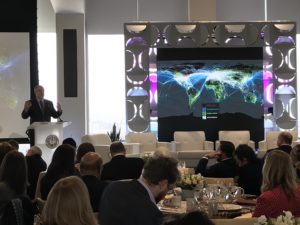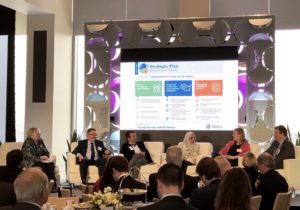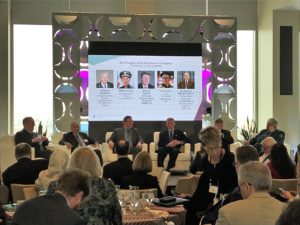Researchers and practitioners from around the world gather at the first Global Resilience Research Network summit

On March 29, 2018 nearly 200 global researchers, government practitioners, and industry professionals gathered at Northeastern University for the first Global Resilience Research Network summit. The session marked the beginning of a two day summit in which researchers and practitioners discussed the barriers that societies around the world must confront in the face of natural and human made disasters. The GRRN is advancing solutions for an array of urgent, complex and interconnected societal challenges. The annual summit is a forum for collaboration on resilience-building efforts among thought leaders, researchers, technical experts, policymakers and practitioners. Updates from the day’s session will follow.
___________________
4:45 PM: Closing Remarks Live on DHS S&T Stream Here
___________________
3:30 PM: Afternoon Panel 3 – Resilience Governance and Incentives
The day wrapped up with a discussion of the barriers to resilience, and the ways to push it forward, namely “Governance and Incentives.” GRI Distinguished Senior Fellow Warren Edwards moderated the last group of panelists: Alfred Puchala Jr., CEO of Capital Peak Asset Management; Ilan Noy, Chair in the Economics of Disasters at the Victoria University of Wellington; Atyia Martin, CEO and Founder of All Aces and Former Chief Resilience Officer of Boston; and Meir Elran, Head of the Homeland Security Program at Tel Aviv University.

Elran and Martin tackled the question of governance and resilience, both stressing the need to align the needs and goals of all levels of society. Elran discussed the different goals of national, regional, and local governments, and the challenges of building a cohesive resilience strategy that involves all of those players. His work focuses on the question of building a strategy together on how to ‘bounce forward’ after a disaster. Martin’s presentation honed in on the individual level of resilience – how do you engage and consider individuals? Bringing vulnerable populations into the conversation is key to building resilience, but current governance needs to adapt to consider the needs of marginalized groups and communities, and at a basic level interrogate existing systems for built in inequalities. Introducing equitable policies is the only way to spread resilience through those who need it most. Both highlighted the dangers of making assumptions in different ways, which is risky at any time, but especially when building resilience.
The conversation next moved to the economic side of resilience, with panelists Alfred Puchala and Ilan Noy. Noy talked about insurance, namely the insurance gap. While only 10% of Californians have earthquake insurance, almost all New Zealanders hold it after a series of devastating earthquakes, he noted. However, a resilient approach is not as simple as just having widespread insurance coverage. After the earthquakes in New Zealand, businesses that had insurance and were paid promptly recovered well, but businesses with insurance and delayed payments recovered the same or worse as those without insurance entirely. Noy described most insurance systems as regressive, saying; “they take money from the poor and give it to the rich”.
Puchala stated that people not understanding how financial systems work is a key barrier in getting those systems to work for them. On the other side, the allocators of capital often lack the data and “on the ground information” needed to know where to direct it to have the most positive effect. Puchala argued that a key to breaking down this barrier is leadership which can make change a priority and a passion, and capital will follow.
As one of the attendees concisely described, it is key to identify the end purpose when we create any system. Moving forward, we hope this summit is a step towards including resilience in that purpose, which, as Puchala said, means we have to involve each individual.
___________________
2:30 PM: Afternoon Panel 2 – Baking in Resilience
Building on the earlier conversation about understanding risk, a panel of experts discussed how we can better design for those risks. Najib Abboud from Thorton Tomasetti moderated the second panel on “Baking in Resilience.” The conversation was led by: Dr. Humberto Cavallin from the University of Puerto Rico School of Architecture; Daniel Hiller from Fraunhofer, Ernst-Mach-Institute in Germany; Prof. Jim Harris from the Cranfield Soil and Agrifood Institute in the UK; Prof. Xiangrong Wang, Director of the Center for Urban Eco-Planning & Design at Fudan University in China; and Prof. Giovanni Sansavini, Head of the Reliability and Risk Engineering Laboratory at ETH Zurich.
This group of distinguished panelists came back to the morning’s ideas about preparation and recovery, this time from a design and engineering perspective. As the world becomes increasingly interconnected, and more than 50% of the population lives in urban areas, how we design our infrastructure is increasingly critical to disaster resilience. As one of the speakers described in the morning session, one of the challenges was looking at the best solution rather than the new or exciting solution.
Much like the approach to the human side of resilience, Prof. Sansavini spoke about managing infrastructure as a network and the need to adapt and unlock new resources as a disaster unfolds. This also requires a holistic perspective, where instead of assessing the resilience of each individual piece, practitioners focus on the overall functions of a system. Prof. Harris furthered this theme by talking about the need to design and update systems to be adaptive over time and in response to changing circumstances. He talked about how the London sewer system was designed over a hundred years ago, and now has to deal with increasing urbanization and overall population growth. Part of adaptive infrastructure is also working on ways to predict disasters.
Prof. Wang revisited the topic through an examination of China’s city approach to resilience. Researchers there are working with a test case of seven cities, especially ones along the coastline that are susceptible to climate change, to work on developing smart, resilient cities, in partnership with UNESCO. Daniel Hiller next spoke about new construction, saying that as new districts were built in Copenhagen or new harbor projects were developed, they needed to take a resilient approach. This includes integrating software engineering tools, and thinking about the both the knowns and unknowns and business continuity. It is critical to understand not just what an organizational response will be in the event of a disaster, but also what they rely on — and have a plan to recover those functions.
Dr. Cavallin brought the conversation into current events, talking about the recovery and Puerto Rico. Resilient infrastructure isn’t just about its direct function, but also its larger impacts. Research in Puerto Rico has looked at the fungi that has grown in homes from water damage, and the health impacts on the population. These human impacts must be taken into account. This is especially key as it is easy to focus on urban infrastructure, but as Dr. Cavallin pointed out, it is often the rural areas like the mountains of Puerto Rico which suffer the longest after a disaster. Much like with communities, a larger cultural shift towards resilience is needed.
“The way we educate engineers still today does not satisfy what future resilience engineers need as expertise and knowledge” said Mr. Hiller. “We start now with our collaborations between Fraunhofer and Northeastern etc.; we need new educational programs. New engineers need to design and calculate differently and we need a new curricula.”
___________________
1:00 PM: Afternoon Panel 1 – Risk Literacy and Education
GRI Executive Director Robin White led the first afternoon panel, entitled “Risk Literacy and Education.” Participating was Professor Paul Arbon, director of the Torrens Resilience Institute in Australia; Dr. Gonzalo Bacigalupe, Principal Investigator at CIGIDEN in Chile and Professor Counseling and Psychology at UMass Boston; Dr. Nadia Al-Mudaffar Fawzi head of the Biological Development of Shatt Al-Arab and the North Arabian Gulf and Professor at the University of Basrah; Dr. Brian Helmuth, Professor of Environmental Science and Public Policy at Northeastern; and Dr. Melissa Forbes, Acting Associate Director of FEMA’s Office of Policy and Program Analysis.
Dr. Arbon opened the discussion by describing how as our systems have become more complex and interdependent, we have also exposed ourselves to cascading risks. Dr. Arbon used Australia’s fuel supply system as an illustrative example of how disruptions to seemingly distant areas can have severe impacts down the supply chain. Much of Australia’s fuel supply comes from ports in Singapore that face risks from storms or congestion. In fact, Australia generally only has 15 days of backup fuel supply. This interdependence provided a microcosm of the connectivity that affects communities of all sizes and must begin to be prioritized in planning.

Briefly exploring how emerging technologies and strategies can help address this complexity, the panelists discussed the different tools and approaches their work is striving to build to understand risk. Among the key themes emerging from the panel was the need for stakeholders from across the resilience spectrum – researchers to practitioners to civil society – to look at risk from someone else’s perspective. Dr. Fawzi, told a poignant story about the Iraqi government building a much needed bridge with a modern design, without talking to the community about what they needed or could manage. When the government left, and did not maintain the bridge, it fell into disrepair. However, when traditionally designed bridges were built in the area, residents knew how to maintain and repair them, and they could continue to serve the community and even save lives.
Dr. Helmuth pointed out that approaches to resilience have inherent tradeoffs, using the example of tide gates, which are used around the world to control flooding. He explained that the operators of the tide gates face difficult decisions on when to open or close the gates. If left open during severe tides, the areas can flood and ruin homes or other structures. However, if closed too long during a storm, the changes in the ecosystem can end up fostering growth of plant life that is highly combustible. The panelists agreed that support tools that better illustrate the conditions and trade-offs can help inform better decisions in a complex operating environment.
Dr. Forbes illustrated FEMA’s new strategic approach to building resilience, with a particular focus on creating a “culture of preparedness” by educating individuals. She explained that many of the things people can do are “low cost or no cost” and can make a large difference in protecting lives and enhancing their communities more broadly. The federal government still has a large role to play. Building trust and cooperation starts with individual relationships which ultimately can help to create a culture of preparedness across many interdependent sectors. In achieving these goals, Dr. Forbes said, “The academic community is a critical partner in the work that we do.”
A final theme which emerged was the importance of working from the bottom up with local communities, rather than the top down, and establishing trust between organizations and people. This bottom up approach includes the tools described, as many of the key decisions made around resilience come from the individual stakeholder level, rather than the national level. Dr. Bacigalupe described a tool being developed at CIGIDEN which would enable local communities to use drone technology to better observe their conditions after a disaster and have training for residents to help the recovery from the bottom up. As these researchers work to bridge the gap between theory and practice, they provided some key lessons about building community and individual resilience.
___________________
10:30 AM: Big Thoughts About Resilience

The GRRN’s first panel featured “Big Thoughts About Resilience” and included esteemed guests Albrecht Broemme, President of the German Federal Agency for Technical Relief; William Evans, the City of Boston’s Police Commissioner; Judge Emmett from Harris County; Ian Hopkins, Chief Constable of Manchester UK; and Dr. Kuntoro Mangkusubroto, Former Head of Aceh-Nias Rehabilitation and Reconstruction Agency in Indonesia. They all brought fascinating and insightful disaster response experience with them. Broemme and Emmett have managed the response and recovery from multiple 100-year flood events in their communities. Evans and Hopkins led the police forces that responded to horrific terrorist attacks in Boston in 2013 and Manchester last May. Mangkusubroto was put in charge of the recovery of the island of Aceh in Indonesia after the record breaking tsunami in 2005.
Across these disasters, a few themes emerged from the conversation. Each panelist emphasized the importance of civil society in response, and the ability of volunteers and citizens to provide help. Additionally, it is key to train people in all departments and levels of emergency response to make important, real-time decisions, as no plan is ever going to be perfect, especially given the complexity of regions and the severity of events they have each managed. The ability to find resources when and where they are needed is more important than perfectly following an emergency plan. Some forms of “training” are necessary outside of professional responders as well, the panelists agreed. Evans pointed towards the “if you see something, say something” campaign that has been heavily publicized following recent disasters as a way of helping law enforcement identify threats and, as importantly, teaching people how to respond. Informing the public of risks so they can better prepare themselves was identified as a critical imperative to bolstering societal resilience.
[CLICK HERE to watch video of the panel on Facebook]
Hopkins and Evans spoke about the incredible whole community response to a traumatic event, and the need in the days following to take care of the mental health of everyone who may be impacted. Both told personal stories and those of their officers about the importance of seeking out support after being asked to respond to such traumatizing events. Even for highly trained responders with years of experience, disasters of that magnitude, in their own communities, will inevitably leave a mark on law enforcement, emergency medical personnel, and the other professionals who arrive just minutes after an attack.
Finally, the panelists stressed the importance of empowering civil society and building trust. Mangkusubroto talked about designing emergency recovery strategies so that people can continue to operate independently after outside help leaves. He noted that communities cannot be resilient if they have a continued reliance on emergency managers and outside resources. In the aftermath of the devastating tsunami, he purposely limited his term to four years because he felt that any longer would create dependencies on national and foreign aid that would keep the islands from returning stronger. This shift required honest engagement with citizens that would foster trust. Emmett shared that the time immediately after a disaster is when to admit your mistakes and push for legislative changes. Of course, these changes are never easy or cheap, but Broemme pointed out that even though resilience measures are not the cheapest options, they pay off in the long run. All of these panelists talked about the need for everyone to recognize the ongoing need for resilience, rather than a one time effort, hopefully jumpstarted by the conversations and connections made at summits like this.
___________________
9:45AM: Morning Keynote – Judge Ed Emmett, Harris County, Texas

Judge Ed Emmett, CEO of Harris County, TX opened the summit with the keynote address, speaking about his experiences with emergency management during and after Hurricane Harvey. Hurricane Harvey hit Houston this past summer, as the third major flooding event in the last three years to impact the city. Over 100,000 homes were flooded. As described by Judge Emmett, “The rains brought on by Hurricane Harvey totally changed my life and my job.”
Throughout his address, Judge Emmett focused on the importance of everyday people in emergency response and the critical imperative that resilience plays in protecting people in communities around the world. He described roads which were too flooded to allow emergency responders to pass and 911 lines that were overwhelmed with calls for assistance. The county turned to the everyday people who had the capacity to come help. People with boats and supplies came from all over the county, state, and around the Gulf to help rescue and evacuate the thousands of people flooded into their homes. Judge Emmett said the county resembled the infamous water evacuation of Dunkirk. While the rest of the country lauded Harris County Emergency Management for bringing in civilians, Emmett acknowledged that people were going to come help no matter what, and said all he did was organize. Further, as all of the shelter plans the county had in place were overwhelmed, they went off-book and worked with Baker Ripley who set up a ‘world class shelter’ in six hours. Judge Emmett emphasized that their ability to deviate from their set emergency plan, to be flexible, adapt, and find new resources led to an emergency shelter effort, has become a model for future planning.
As Judge Emmett gave his formula for resilience (sum prevention, preparation, response, and recovery, multiply by policies, priorities, and resources) he emphasized the need for people at all levels to be involved with emergency response and preparation resilience efforts. While there are always shorter term priorities which take precedence over long term resilience, Emmett said that as he drove by the piles of debris after the rain stopped, the entire substance of people’s lives stacked on the curb, his world changed. We all need to invest in resilience together, learn from each other, and move resilience from theory into practice, he stressed. Beyond valuable lessons from responding to the largest disaster to ever hit Houston, Emmett reminded us all that the challenges that GRRN will help to address will make a real and important difference to emergency managers and the lives of the everyday people they protect.
